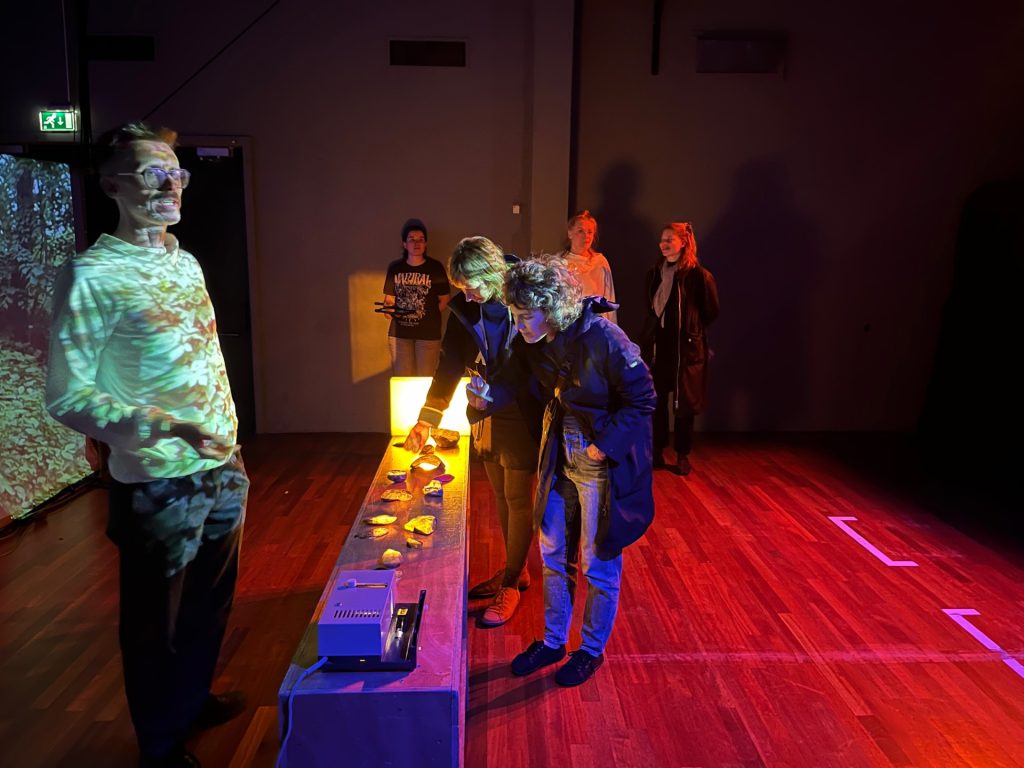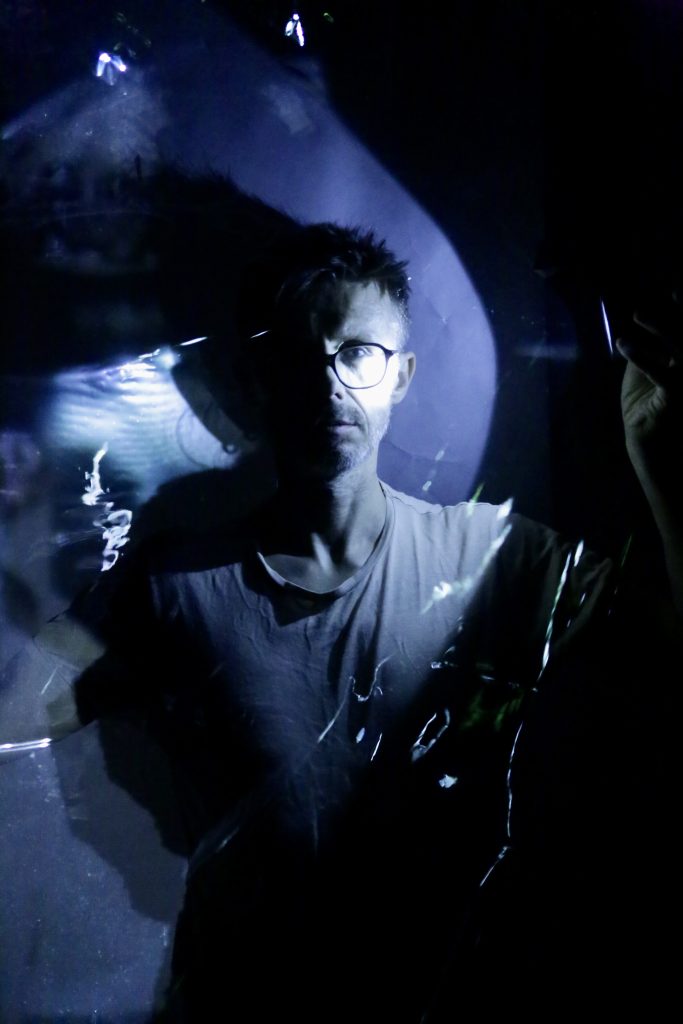
SPRING Reporters: collection of
SPRING reporters Floris van den Berg and Leonie de Groot reported the performance collection of by Turkowski & Nowacka.
Chocolate Wrappers as Decoration
“Let us never forget the terrible past that lies behind us, but not as a way to keep us negatively chained to the past, but rather as a happy reminder of how far we have come and how much we have achieved.” — Nelson Mandela
We are welcomed by the Polish host. The audience stands around him in the twilight. On a table lie stones and shells, illuminated by a faint orange light. The audience is allowed to pick up the collection of stones – something you wouldn’t be allowed to do in a museum. Photos are shown with two projectors. I think back to how we used to have slide evenings at home. The screen was hung up, the projector set up on a special stand, the curtains tightly closed. My father would then load the slides into the tray. I can hear the sound of the slides changing: click-clack. The swirling dust visible in the bright light of the projector. The slides sometimes mirrored or upside down. A family affair. We know the slides and the stories. We laugh at the same things. That’s over. Slides are now history. Everything is digital now.
The two theater makers, a Polish couple, tell a story about the collection of thousands of slides and film and photo material they came into possession of. The material is the collection of the father of someone named Joost, a wealthy businessman who traveled the world. Then, a dizzying series of narratives unfolds in the theater. It’s like One Thousand and One Nights, one frame story within another. We see not only photos of Joost’s family but also slides and the story of the theater makers themselves, who both grew up in Poland behind the Iron Curtain. In their youth, they collected empty packaging of Western consumer goods: chocolate wrappers, empty cans, cardboard packaging, and cigarette boxes. Not only the children, but the parents also did. They stuck the Western chocolate wrappers to the wall as colorful decoration.
Then the story takes another turn. We are taken to France, where the Polish couple meets an Indonesian dancer. This dancer turns out to have been born in the place where the Dutch (colonial) researcher Eugène Dubois conducted excavations in search of human fossils. Not that Dubois was digging himself. It was dozens of local men who dug for him. Dubois found the so-called Java Man, an ancestor of Homo sapiens. The excavations are now in the Leiden Ethnological Museum. So they go there with this Indonesian dancer. Then the performance is suddenly over, and I am left with a head full of questions.
At flea markets, I sometimes see family albums. It feels strange to look at an album of someone you don’t know. You recognize events: birth, birthday, wedding, vacation, Christmas, but it has an emotional distance. Oddly enough, that distance is already there in a photo album of your grandparents, where most people are strangers. The photo story performances seem to be about identity: who am I as a person? What do cultural differences say about your identity? Joost grew up in a wealthy family in the capitalist world, the Polish couple behind the Iron Curtain under a communist regime in a meager world. As humanity, we all go back to Java Man. We are different but share our evolutionary history.
In an hour, an overwhelming number of photos and videos have passed by. I try to make a unity of it, but I can’t. I have to let it go. A cosmopolitan story about people’s stories. We all have our own story. By getting a glimpse into the loosely connected stories of others, a sense of connectedness arises. In any case, I’m going to ask my father if he still has the slide projector somewhere so that we can illuminate the past once again. How different it is with the tens of thousands of photos that disappear into our clouds. How much of the past do you want to carry with you? How much of the past is unique and how much is generic?
And that is precisely SPRING: a performance you couldn’t have imagined and which brings you thoughts you wouldn’t have otherwise.
– Floris van den Berg

When do you look at something?
When you look at an object by the light of “Sunrise of the Moonlight,” you see the objects in a very different light than under bright fluorescent tubes or other lamps.
The audience enters the small theater room of the Kikker. We receive an explanation about a small collection of stones displayed under a soft, yellow lamp. It almost seems as if these stones come from prehistoric times. Perhaps you could even make fire with them.
We are allowed to touch the stones, but not many people from the audience do so. I take a stone in my hand; it is not very heavy. It is also mentioned that one of the stones resembles “Screaming Martin.” This is, of course, the storyteller’s imagination.
After about fifteen minutes, we are asked to take seats on chairs and cushions. The duo Turkowski and Nowacka tell us, through a presentation on a folded screen that resembles a tent, about their collection. For example, they have 6.5 thousand slides on porcelain from China. They now consider themselves specialists in archiving, although they are not officially trained in it.
They possess a collection from Mr. Phillis from the period 1948-1956. The collection contains only five photos from 1948. Capitalism and colonialism are clearly reflected in this collection. The question is asked: Why did Joost care about this collection? He was curious about what Turkowski and Nowacka would do with it and if they could properly appreciate the value of the photos.
In 2006, Joost went to Indonesia with his parents for four weeks to write a book. Unfortunately, the book was never published. Should this project be about Joost, his father, or both? Perhaps the intention was to seek confrontation with his father.
In Poland, they collect packaging for decoration. A book about monuments worldwide is shown; a kind of Bible for this duo. They went to the Eastern Scheldt, despite initially wanting to avoid it. In hindsight, it turned out to be very interesting. They also went to the caves in southern France to study the murals. There, they also took a Buddho dance course, which told more about the history of Indonesia. The monkey is compared to a human. We see someone from Indonesia observing the place Jaffa on the screen. He also observes us. A shaman, difficult to translate into English, a healer.
The duo concludes with the words: “We can tell you more about our collection and journey if you are not tired…”
My thought: “Behind every collection lies a story,” this story forms a shared history. When something new is discovered, the shared history changes. Each generation grows up with its own story and seeks its roots. Where do I come from? Where am I going? A collection can give meaning, keep stories alive, and sometimes even change the shared history….”
– Leonie de Groot